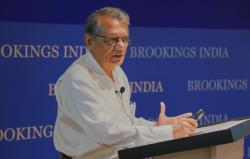This chapter comes from “Beyond Neoliberalism: Insights from emerging markets,” a report exploring the ongoing debate over the future of capitalism and policy choices across a range of domains.
Broad consensus had been achieved around dominant neoliberal thinking in relation to financial sector regulation and monetary policy in the two decades leading up to the North Atlantic financial crisis (NAFC) that erupted in 2007-08. Whereas this thinking was essentially developed and applied in the advanced economies (AEs), similar policy prescriptions were advocated for emerging market economies (EMs). The general view was based on two theoretical propositions: the Efficient Markets Hypothesis (EMH) and the Rational Expectations Hypothesis (REH). “The EMH defines an efficient financial market as one in which securities prices fully and rationally reflect all available information…”1 The REH “proposed that individual agents in the economy—be they individuals or businesses—operate on the basis of rational assessments of how the future economy will develop.”2 Based on the belief that financial markets operate efficiently, it was assumed that free competition in financial markets would result in the efficient allocation of capital across the economy, and hence promote growth. And belief in the REH suggested that both individuals and financial institutions are capable of managing risks. The corollary was that regulation should be light touch only.3
Continued development of financial markets should therefore be encouraged; increasing financial depth and intensity is good for promoting economic growth, along with financial inclusion; and continued financial innovation helps price discovery, which promotes efficiency in the allocation of financial resources. “The pre-crisis orthodoxy was built on the idea that even if financial markets were in some ways imperfect, market liberalization and competition would at least bring us closer to perfection.”4 Such a theoretical view saw the economy and financial markets as being inherently self-stabilizing and efficient in allocating resources. A process of financial deregulation and deepening was therefore the order of the day, starting in the 1980s and lasting till the NAFC. Policy advisers to EMs and policymakers in EMs were not immune to this dominant strand of thinking.
Although this period was characterized as the Great Moderation, since the advanced economies experienced relatively consistent growth and low inflation, significant financial instability was experienced in different jurisdictions. Approximately 100 crises occurred during the 30 years before the NAFC, during which financial liberalization policies were dominant.5 Over this period, the financial sector grew much faster than the real economy in the advanced economies: private sector debt grew from around 50 percent of GDP in 1952 to 170 percent by 2006; trading in foreign exchange markets grew much faster than exports and imports; trading in commodities exceeded growth in commodity production; gross cross-border capital flows grew far in excess of investment; and financial innovation flourished with the introduction of widespread securitization and derivatives.6 The financial sector began to serve itself much more than the needs of the real economy. This relative explosion in financial sector development across the world was clearly not reflected in the real economy.
The excessive growth in overall debt and leverage in financial institutions, explosive growth in cross-border capital flows, along with the development of global macro and financial imbalances, finally led to the outbreak of the NAFC. This shock, the worst financial crisis since the Great Depression, has been instrumental in raising fundamental questions with respect to basic tenets of the neoliberal financial order outlined above. The key lesson from this crisis has to be that financial markets on their own are not necessarily efficient, stable, or self-correcting: “serious economic and financial crises can happen, even in low inflation advanced market economies.”7
Thus governments, central banks, and financial regulators have a crucial role to play in overall economic and financial sector regulation and management. Light financial regulation can no longer be sustained.

This work is licensed under a Creative Commons Attribution 4.0 International (CC BY 4.0)
-
Footnotes
- Turner, Adair. 2016. p. 37. Between Debt and the Devil: Money, Credit and Fixing Global Finance. Princeton N.J.: Princeton University Press.
- Ibid. p.38
- Group of Thirty. 2015. p. 9. Fundamentals of Central Banking: Lessons from The Crisis. Washington D.C.: Group of Thirty.
- Turner, Adair. 2016. p. 37. Between Debt and the Devil: Money, Credit and Fixing Global Finance. Princeton N.J.: Princeton University Press.
- Stiglitz, Joseph E. 2014. “The Lessons of the North Atlantic Crisis for Economic Theory and Policy”. Chapter 29, p. 335. In George Akerlof and others, 2014. (In his comments Homi Kharas quoted a figure of 412 financial, banking and sovereign debt crises in the last 40 years, derived from IMF documents.)
- Turner, Adair. 2016. p. 1. Between Debt and the Devil: Money, Credit and Fixing Global Finance. Princeton N.J.: Princeton University Press.
- Group of Thirty. 2015. p. xii. Fundamentals of Central Banking: Lessons from The Crisis. Washington D.C.: Group of Thirty.
The Brookings Institution is committed to quality, independence, and impact.
We are supported by a diverse array of funders. In line with our values and policies, each Brookings publication represents the sole views of its author(s).




